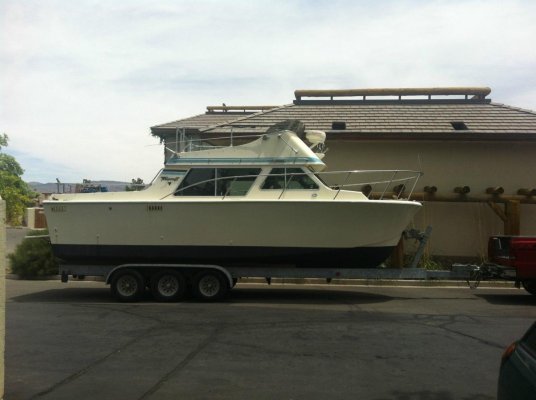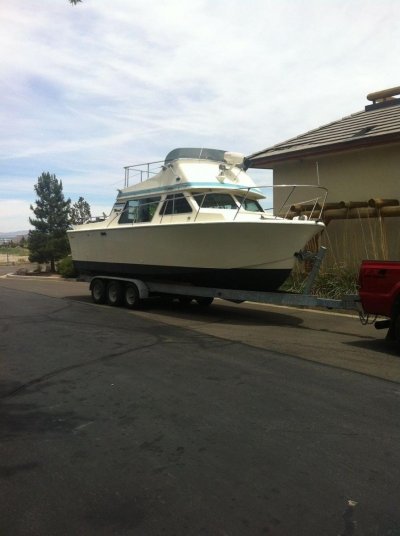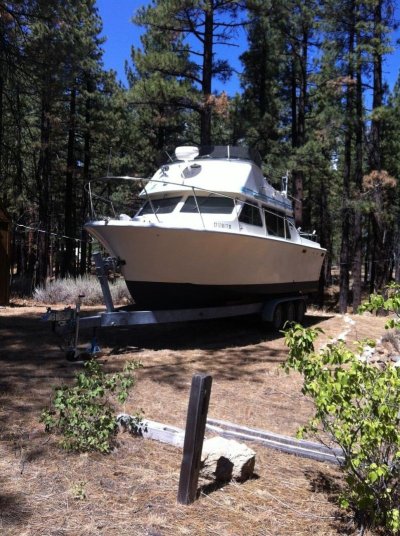TollyLucia
Veteran Member
Hello everyone, I've been reading this forum for a while now among others on the internet. Although I know my boat isn't exactly a trawler, you guys seem to know your stuff and I believe would have the closest (compared to say, center console forums, etc) advice I can find to what I want to do. Also please forgive my ignorance, I am asking, no begging for help here.
Well, without much more, here's my boat. A 1979 Tollycraft 26. She's got twin gas 3.8L GM V6's. No generator or air conditioning. Batteries completely shot. I should have mentioned, I am doing a complete restoration.. so almost anything is possible (within reason). Many of my projects on the restoration are started (engine's rebuilding, new fuel tanks, interior, etc). I have started to contemplate my electrical system, now would be a good time to start as the boat is pretty much apart.
Goals for my boat:
1. NOT living aboard
2. Stored on a trailer
3. Will be used for 1 to 3 week trips. These will be mostly spent anchored out. But several nights of a 3 week trip would be in a marine, on shore power.
Goals for my electrical system:
Loads:
1. Small air conditioner, 8 to 15 amp/hour range
2. Small refrigerator
3. Anchor windlass, small
4. Interior and Exterior lights
5. Electrical equipment - Radios, GPS, small computer, etc
6. Bilge Pumps
Operational modes needed:
1. Underway - two engines, I can have two alternators.. hopefully large enough to power everything above by themselves?
2. Shore power - Hopefully all systems could be powered via shore power?
3. Not underway - Generator. I know the AC draw will be the hardest to manage. I need help here.
Here is what I am thinking, and PLEASE, correct me if I am just flat wrong.
WARNING - PLEASE NO ONE SEARCH AND FIND THIS AND THINK THIS IS GOOD ADVICE, I AM ASKING THIS AS A QUESTION
1. Properly sized inverter connected to 1 or 2 250+ AH batteries.
2. Couple high AMP alts on the engines to charge the batteries underway.
3. Battery charger to charge batteries from shore power when connected.
4. Generator to charge batteries when at anchor.
5. Run all AC loads always off inverter / battery(s) always. (Big Question here)
6. DC loads off batteries.
7. Myriad of switches or auto switches to accomplish this.
8. Start batteries for engines thrown in somewhere..
Help needed. I'm ready for a thrashing.
Well, without much more, here's my boat. A 1979 Tollycraft 26. She's got twin gas 3.8L GM V6's. No generator or air conditioning. Batteries completely shot. I should have mentioned, I am doing a complete restoration.. so almost anything is possible (within reason). Many of my projects on the restoration are started (engine's rebuilding, new fuel tanks, interior, etc). I have started to contemplate my electrical system, now would be a good time to start as the boat is pretty much apart.
Goals for my boat:
1. NOT living aboard
2. Stored on a trailer
3. Will be used for 1 to 3 week trips. These will be mostly spent anchored out. But several nights of a 3 week trip would be in a marine, on shore power.
Goals for my electrical system:
Loads:
1. Small air conditioner, 8 to 15 amp/hour range
2. Small refrigerator
3. Anchor windlass, small
4. Interior and Exterior lights
5. Electrical equipment - Radios, GPS, small computer, etc
6. Bilge Pumps
Operational modes needed:
1. Underway - two engines, I can have two alternators.. hopefully large enough to power everything above by themselves?
2. Shore power - Hopefully all systems could be powered via shore power?
3. Not underway - Generator. I know the AC draw will be the hardest to manage. I need help here.
Here is what I am thinking, and PLEASE, correct me if I am just flat wrong.
WARNING - PLEASE NO ONE SEARCH AND FIND THIS AND THINK THIS IS GOOD ADVICE, I AM ASKING THIS AS A QUESTION
1. Properly sized inverter connected to 1 or 2 250+ AH batteries.
2. Couple high AMP alts on the engines to charge the batteries underway.
3. Battery charger to charge batteries from shore power when connected.
4. Generator to charge batteries when at anchor.
5. Run all AC loads always off inverter / battery(s) always. (Big Question here)
6. DC loads off batteries.
7. Myriad of switches or auto switches to accomplish this.
8. Start batteries for engines thrown in somewhere..
Help needed. I'm ready for a thrashing.





